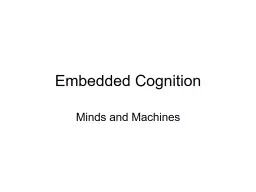

Neil DeGrass Tyson on Human Intelligence The Astonishing Hypothesis You your joys and your sorrows your memories and your ambitions your sense of personal identity and free will are in fact no more than the behavior of a vast assembly of nerve cells and their associated ID: 911187
Download Presentation The PPT/PDF document "Embedded Cognition Minds and Machines" is the property of its rightful owner. Permission is granted to download and print the materials on this web site for personal, non-commercial use only, and to display it on your personal computer provided you do not modify the materials and that you retain all copyright notices contained in the materials. By downloading content from our website, you accept the terms of this agreement.
Slide1
Embedded Cognition
Minds and Machines
Slide2Neil
DeGrass
Tyson on Human Intelligence
Slide3The Astonishing Hypothesis
“You,
your joys and your sorrows, your memories and your ambitions, your sense of personal identity and free will, are in fact no more than the behavior of a vast assembly of nerve cells and their associated
molecules.”
- Francis Crick,
“The Astonishing Hypothesis”
Slide4Brain Gives Rise to Mind Hypothesis
Intelligence, cognition, mind, etc. are all a
function of the
brain
Cognition = f(Brain)
Slide5‘Sense, Plan, Act’
Cognition
Sense
Act
Environment
Agent
(Brain)
Slide6LEGO Robot Solves Sudoku!
Slide7Embedded Cognition
Processing
Sense
Act
Environment
Agent
(Brain)
Slide8Catching a Fly Ball
Slide9The World as External Memory
Embedded Cognition proponents say that the brain often uses the environment as a kind of ‘external memory’.
Examples:
Notes, planners, calendars, even laptops
Slide10No Opposable Thumbs …
Slide11The World As its own Best Model
Situated cognition proponents like to point out that we don’t always form some kind of internal representation of the outside
world
Slide12‘Epistemic moves’:
Moves that are not
part of a solution,
but help find one
Rotating
Slamming
Slide13Blind-Cane-Man
Bob is blind, and uses a cane to feel around.
Is the cane part of Bob?
It isn’t part of Bob as a biological being.
But is it part of Bob as a cognitive being?
There is a cognitive agent here, perceiving the world, thinking about the world, etc.
Is the cane part of the cognitive agent, or part of the world?
Is Bob a
cyborg
?
Slide14Does Tool Use create a new Cognitive System?
Cognitive
System A
World
Cognitive
System A
Tool
World
Cognitive System B
Slide15Projection: Imagined Abaci
Slide16Language: Our Best Tool?
Language seems to be an especially powerful tool that we use to enhance our cognitive abilities:
Expressions of language can be used to represent
information and thus serve as external memory (see examples before)
Expressions of language can be
manipulated and thus reasoning and decision-making can take place (logic
, mathematics,
science)
Slide17Some Representations Are Better Tools Than Others …
VI / XLIV \ ??
Slide18Objection: Higher-Order Cognition without Interactions
OK, but then what about someone who is just sitting in a chair, contemplating something or other?
Slide19Cognitive
Agent
A
World
Cognitive
Agent
A
Representation
o
f World
World
Cognitive System B
Slide20Culture
Slide21Wallace’s Paradox
Slide22Darwin
Wallace
Slide23Culture
Culture is the whole of:
Ideas and Concepts
Knowledge and Beliefs
Behaviors and
H
abits
Practices and Methods
Tools and Skills
…These aspects of culture exist in ‘social space’ … not in your head.
But they clearly enhance your cognitive abilities.
Slide24Language and
Cultural Transmission
Again, language plays a key role in cultural transmission, since we can use language to
describe
:
Thoughts, Concepts, Ideas,
Beliefs,
Tools, Skills, Behaviors, Habits, Procedures, Routines, …
And these descriptions are more easily transmitted, and they last: they can be passed over great distances in both space and time.
Slide25Cultural Evolution of Cognition
Once culture is in place, cultural evolution can work on components of cognition.
For example, such cognitive ‘building blocks’ as concepts or ideas, but also fashions and values can be passed from organism to organism, where they ‘compete’ for existence (certain ideas strike us as better ones than others’, and can get mutated or combined with others: all the ingredients that an evolutionary process requires.
Richard Dawkins coined the term ‘memes’ for these kinds of entities that are subject to cultural evolution.
Slide26Cultural Evolution
Exhibit
A:
Theory of Evolution
Darwin
Wallace
Slide27Calculus
Leibniz
Newton
(building on the work by Archimedes,
Kepler
, Fermat,
Roberval
,
Cavalieri
,
Descartes, Lagrange, Huygens, Barrow, and many others …)
Newton: “If I have seen further it is by standing on the shoulders of giants
.”
Slide28Who Invented the Computer?
Instructions
Symbol
manipulation
Computations
Machines
Mechanization of Computations
Programmable Machines
Programmable Computers
Universal Programmable Computers
Pascal’s Calculator
‘Digesting’ Duck
Jacquard Loom
Babbage Difference Engine
Turing Machine
Slide29How our Brain Integrates Technology: Perception
Slide30How our Brain Integrates Technology: Action
Slide31Hammer-Man!
Hammers
don’t hit Nails,
People Do!
“If all you have is a hammer,
e
verything becomes a nail”
- Bernard Baruch
Slide32Wallace’s paradox is that our human ancestors from tens of thousands of years ago had pretty much the same brain capacity as we have now. Hence, they should have been able to do advanced mathematics, science, etc. But they didn’t. So it seems like a lot of their brain power wasn’t used. But that goes against the basic tenets of evolution, since evolution wouldn’t favor organisms that waste energy on things that aren’t being used. What is probably the best resolution to this paradox
?
A. The human mind is not physical, so evolution has nothing to do with
it
B. Evolution
*does* waste. We all know we only use 10% of our brain
!
C. One’s
mental capacities are a function not just of the brain alone, but of brain, body, and environment. And while our brains and bodies are essentially the same as our ancestors, we have sophisticated languages and other symbol systems in our environment to do math and science, which our ancestors did not.
Slide33True or False? Leibniz and Newton coming up with calculus at the same time but without any contact is an amazing coincidence
!
A. True
B. False